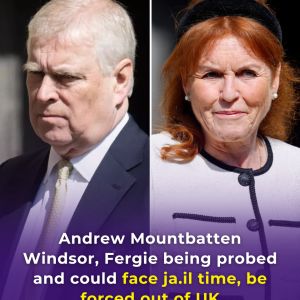
While Andrew Mountbatten Windsor’s loss of his titles last month may appear shocking, history shows it’s not the first time a royal has given up status or duty.
The former prince was stripped of his dukedom, HRH title, and royal honours — including the Order of the Garter and his honorary naval rank — and was ordered to leave Royal Lodge by King Charles.
He now joins a long list of royals who have either been stripped of their titles or chosen to relinquish them, often due to scandal, marriage, or a desire for a simpler life.
Prince Andrew
In October 2025, Buckingham Palace confirmed that Andrew would no longer be referred to as “Prince Andrew” but instead as Andrew Mountbatten Windsor. The decision came after renewed allegations tied to his connection with Jeffrey Epstein.
King Charles III announced that all of Andrew’s styles, titles, and honours were to be removed, and that he would vacate Royal Lodge. “Formal notice has now been served to surrender the lease,” the Palace stated. Andrew had already stepped back from public duties in 2019 following earlier controversy.
Princess Mako of Japan
In 2021, Princess Mako, niece of Emperor Naruhito, gave up her title to marry her longtime partner Kei Komuro, a commoner. Their engagement faced harsh public scrutiny, but Mako expressed relief to “start a new life” after their quiet registry office wedding.
Prince Harry and Meghan Markle
The Duke and Duchess of Sussex shocked the world in 2020 when they stepped down as senior royals. After a brief stay in Canada, they settled in California with their children, Archie and Lilibet. Though they retained their titles, they no longer represent the Crown officially.
The Duke and Duchess of Windsor
Perhaps the most famous abdication came in 1936 when King Edward VIII gave up the throne to marry Wallis Simpson, an American divorcée.
“I have found it impossible to carry the heavy burden of responsibility without the support of the woman I love,” he said in his broadcast address. Edward was granted the title Duke of Windsor but was denied a royal role thereafter.
Princess Märtha Louise of Norway
In 2019, Princess Märtha Louise stopped using her title for business purposes after controversy over a speaking tour with her partner, Shaman Durek Verrett.
She later relinquished her royal patronages altogether. Although she retained her princess title, she no longer represents the Norwegian Royal House. In 2024, she married Durek, who was not given a royal title.

Prince Philip
Born into the Greek and Danish royal families, Prince Philip renounced his original titles and converted to Anglicanism to marry Princess Elizabeth in 1947. He became the Duke of Edinburgh and adopted the surname Mountbatten, later serving as Queen Elizabeth II’s Prince Consort.
Queen Beatrix of the Netherlands
Queen Beatrix abdicated in 2013 after 33 years on the throne, passing power to her son, King Willem-Alexander. Her decision followed a family tradition — both her mother, Juliana, and grandmother, Wilhelmina, had abdicated before her.
Emperor Akihito of Japan
Emperor Akihito, who began his reign in 1989, became Japan’s first monarch in over two centuries to abdicate when he stepped down in 2019 due to health issues. His son, Emperor Naruhito, succeeded him.
Diana, Princess of Wales
After her 1996 divorce from then-Prince Charles, Diana lost her HRH title and became simply Diana, Princess of Wales. Though discussions later arose about restoring her royal style posthumously, her family declined, believing she would not have wanted it.
Princess Ayako of Japan
Before Princess Mako, her cousin Princess Ayako gave up her title in 2018 to marry commoner Kei Moriya, a shipping executive. She now goes by Ayako Moriya.
Queen Margrethe II of Denmark
In 2024, after 52 years as monarch, Queen Margrethe abdicated in favour of her son, King Frederik X. “Such an amount of time leaves its mark on anyone — also on me,” she said in her announcement.
Prince Michael of Kent
Queen Elizabeth II’s cousin lost his place in the line of succession when he married Roman Catholic Baroness Marie-Christine von Reibnitz in 1978. The Succession to the Crown Act 2013 later restored his position, though he remains far from the throne.

Peter Phillips and Zara Tindall
Princess Anne declined royal titles for her children so they could live more normal lives. Zara Tindall later said, “I was very lucky that my mother didn’t give us any titles.”
Sweden’s Royal Grandchildren
In 2019, King Carl XVI Gustaf removed royal house status from most of his grandchildren to allow them greater personal freedom, though they retained their prince and princess titles. Only Princess Estelle and Prince Oscar, children of Crown Princess Victoria, remain expected to serve as working royals.
King Juan Carlos I of Spain
King Juan Carlos abdicated in 2014 in favour of his son, King Felipe VI, after nearly 40 years on the throne. He later retired from public life and temporarily lived in the UAE following corruption allegations, which were ultimately dropped.
From abdications and divorces to love stories that defied royal convention, these examples show that stepping away from royal duty — whether by choice or consequence — has long been part of monarchy’s complicated history.




